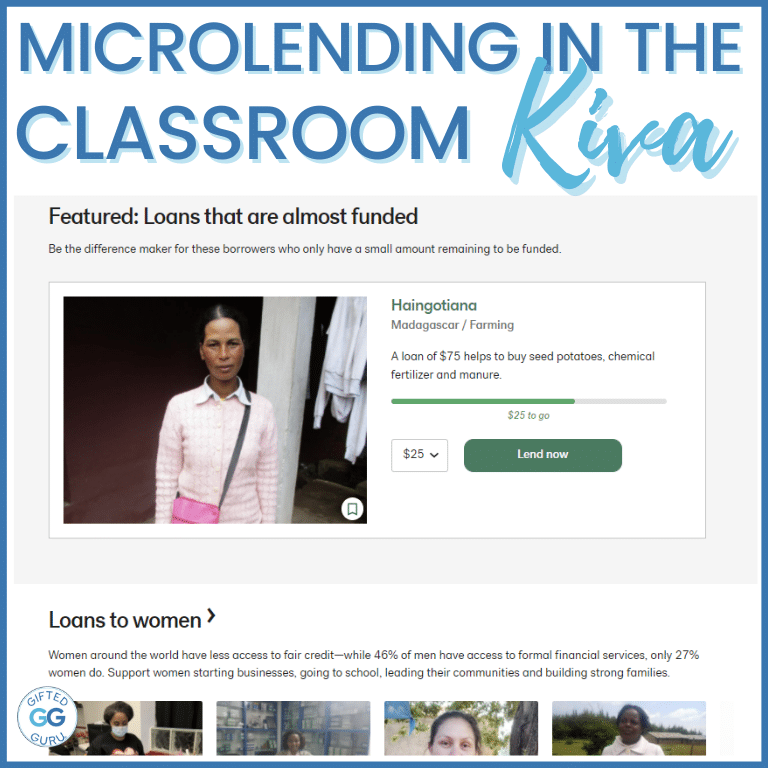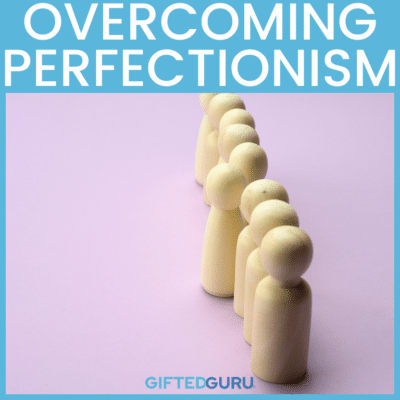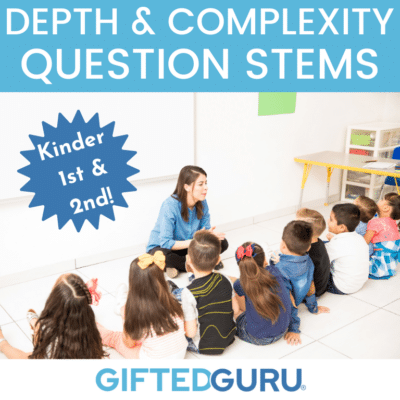Microlending in the classroom can be a powerful yet simple tool for nearly every educator.
I’ve used Kiva for microlending in my classroom, and I’m sharing some ideas for those of you who have been interested in using microlending in the classroom as part of a global classroom, to teach a specific content, or to build classroom community.
The basic idea: With microlending, very small loans (in Kiva’s case $25) are made by a number of individuals, group funding larger loans. These loans are paid back, and the money can then be re-loaned. Lenders choose the loans based on criteria they choose (groups/individuals, types of loan, length of loan, area of the world, and more). Loans can default, as there is no guarantee of repayment. I have had two loans default in my years and years of lending.
Gifted kids often have early moral concern and are attenuated to the needs of others. Microlending provides a way to support that emotional need in your students.
Microlending in the Classroom: The Global Classroom
I’ve lived in Germany, and my husband is Australian. These facts have influenced my belief in my role as a global educator. No matter where you live, we’re all teaching students to be citizens of a world, not only a nation. I’m descended from five passengers on the Mayflower, so I’m a big believer in patriotism as well, of course.
We can teach kids to love their countries whilst simultaneously teaching them about their role (and their country’s role) in the world community.
Microlending allows this to happen very naturally. As students see the different regions and countries of the world and learn about the people who live there, the realization dawns that people everywhere love their children, are trying to build better lives for themselves, and that we are more alike than we are different.
Microlending in the Classroom: Content Ideas
When I taught elementary school, I taught all content areas. In high school, I taught language arts and social studies. Global classrooms are for all content, though, so don’t think it’s just for geography teachers!
Here are some content ideas:
- Math: Kiva has great analytics to help you track what kinds of loans (agriculture, education, etc.) you have made and to which countries you have made those loans. Use this to teach graphing. You can also use it to teach interest, rate, and other data-driven ideas. Calculate how much each payment will be based on the amount of the loan and payback term.
- Social Studies: In addition to the obvious geography connection, you can use it to teach region (and other themes in geography), climate, human geography, flags, history, and more. Look up the country in the CIA World Factbook and discuss how it is both similar and different from each other. Make loans to countries or regions you are studying.
- Science: Many of the loans involve science aspects, especially the food and agriculture loans. Classes can explore the impact of weather and climate on agriculture or the environmental concerns and challenges in an area. Many loans offer clear chemistry or physics links as well. For example, we made a loan to someone to purchase a peanut grinder. You can explore the physics of the mechanics of the peanut grinder.
- Language Arts: Use the borrowers’ stories as writing prompts. Write about the loan experience. Read stories from the country or region.
- Other areas: microfinance, art, music, general business principles, and PE (games of the country).
Kiva has an entire section of its website devoted to educators and students. It also has an entire step-by-step guide to bringing Kiva to your school. I also like this collection of ideas for teachers.
Microlending in the Classroom: Build Classroom Community
Recently I was in Lancaster, Pennsylvania (read about that here) talking about Kiva with teachers, and one of the teachers there told me about his brother who is a Kiva educator extraordinaire. His class made a video about how they’re using Kiva that is truly outstanding.
Kiva U: An Eternal Impact from David Crowther on Vimeo.
Kiva can build both classroom community and make your classroom feel more part of a world community.
As students work together to make something good happen for someone else, they unite in kind purpose. This is strengthening.
Additionally, you can join Kiva teams that represent organizations you belong to, including alma maters or schools (like David Smith’s team in the video). Kiva has a directory of teams within the education facet of Kiva. You can also create a team of your own.
Microlending in the Classroom: The Practical Side
You may be wondering about how I handle the practical, logistics side of things with microlending. Here are some tips. If you have any questions, simply leave a comment and I’ll respond so everyone can benefit!
- In my district, if you collect less than a dollar from students, you don’t have to track it and turn it in and all of that headache. I got a literal piggy bank for my desk and allowed students to drop change in the piggy bank.
- Loans to groups are less likely to default than loans to individuals, because the group will often be incentivized not to default.
- You can loan the same money over and over, but it takes some time to build that up. I’ve donated $284 over time, yet made about $3,000 in loans.
- Decide how you will determine how to make the loans. You can have students select some possibilities and then vote on them. You can decide on a lending plan (We make agricultural loans to groups in Africa that will be repayed within sixteen months, for example).
- Keep track of your lending in some way other than just in your Kiva account, as your students won’t have individual access to that. If you have a classroom website, share your microlending in the classroom experiences there. If not, consider having some other way to allow students to have a way to share it with others (like their families).
I’ve found Kiva to be a truly wonderful addition to my classroom. It takes less time than you think it will!
If you’ve used Kiva or other microlending platform in your classroom, I’d love to hear about it!

Note: This is not a sponsored post in any way. I just love Kiva!




